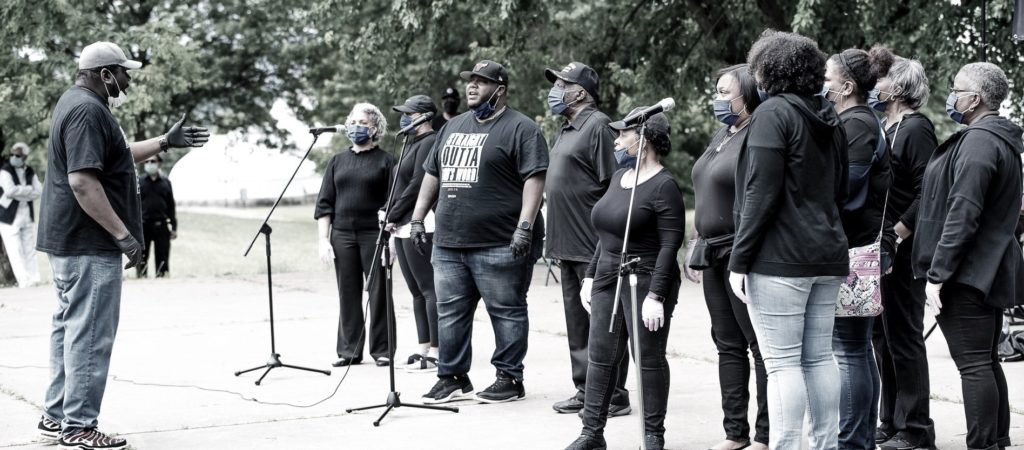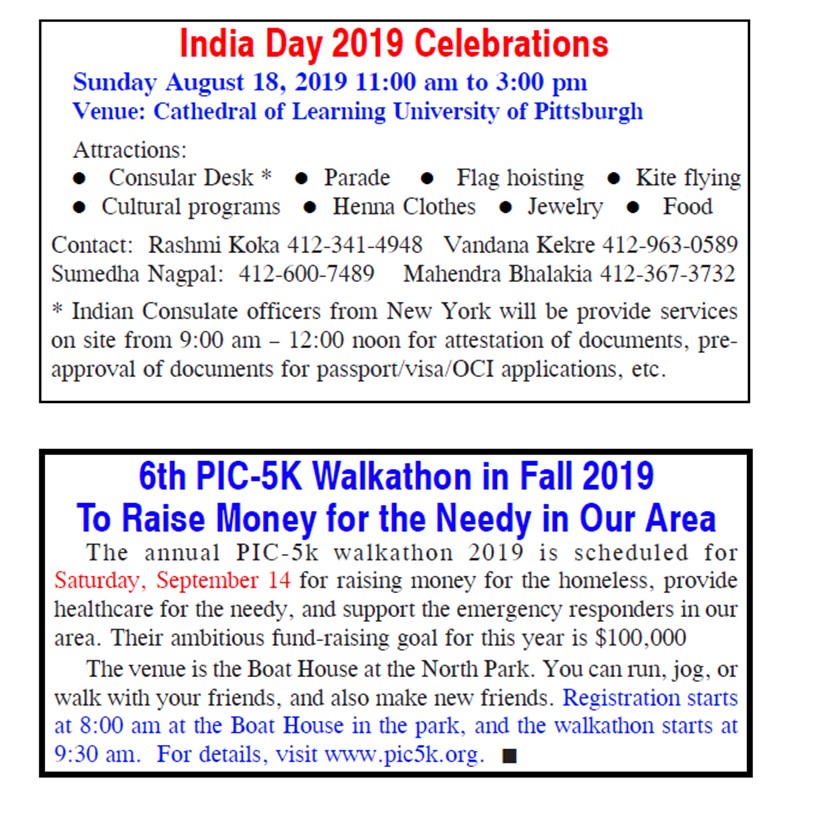Archive for category Past issues
Punarjanma — Rebirth
Posted by admin in January 2021, Past issues on December 29, 2020
By Dolly and Juginder Luthra, Weirton, WV dolgin1968@gmail.com
Note: Last autumn, I followed a set of deciduous trees taking daily pictures to track their color change, and posted 20 of these daily pictures on-line to show their transitions: https://tinyurl.com/FiveTreesAutumn. The three pictures shown below are from these pictures posted on-line. Dolly & Juginder Luthra, after seeing the trees in transition on-line, sent the poem they had written sometime ago inspired by a similar scene. — By Kollengode S Venkataraman.
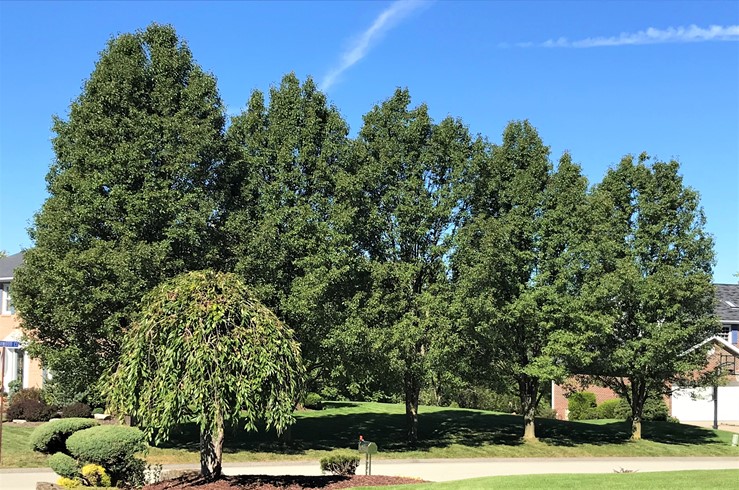
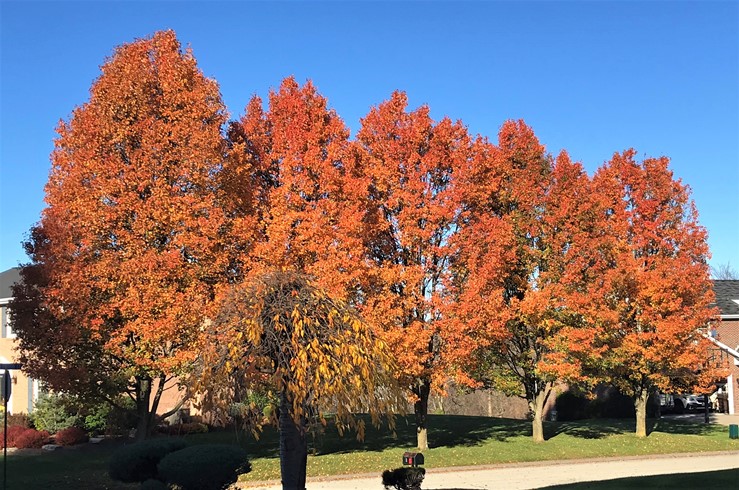
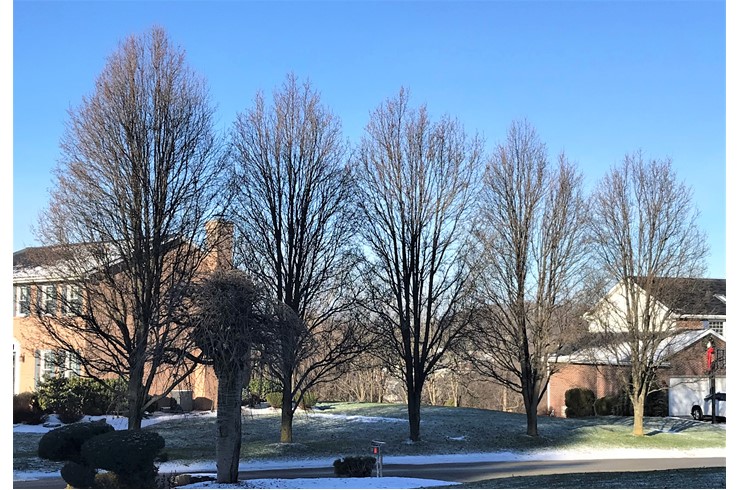
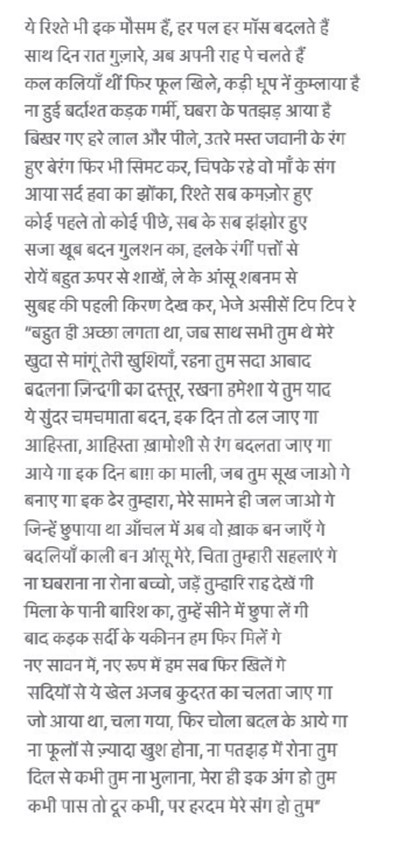
Relations are seasons, changing each moment, every month
Spent days n nights together — now on own paths
Buds yesterday, then flowers bloomed, withered by sunshine
Couldn’t tolerate the blistering heat; then nervously Fall arrived
Scattered green, red & yellow, the intoxicated youthful colors faded
Colorless they wound up, staying connected with their mother
Came one gust of cold wind, all relations weakened
Some first others later, all got shaken
And the garden’s body decorated by faded colored leaves
Cried branches from above, drawing tears from dew
First ray of sunshine, sent blessings — drip drip drip
“Felt very good when you were with me
Asked God for your joy, may you live forever
Change is way of life, you always must remember
This shiny body, one day will weaken
Silently slowly this color will keep changing
One day gardener will come when you’re fully dry
Piled into a heap, you will burn in front of my eyes
Not too long ago, I hid you in my lap; now you become ashes
Black clouds become teardrops, and caress your pyre
Don’t worry or cry, my children, roots will look for you
Mixing with rain water, they will hide you inside my bosom
After bitter cold surely we will meet again
In new spring, in new form, we will bloom again
For centuries this play of nature will go on
One who came, left, then returns in altered garb
Don’t be overjoyed in Spring — nor cry in Fall
Never forget in your heart, you’re my body part.
Home:
Obituary: Tandav Magge (1932 to July 24, 2020)
Posted by admin in January 2021, Past issues on December 29, 2020
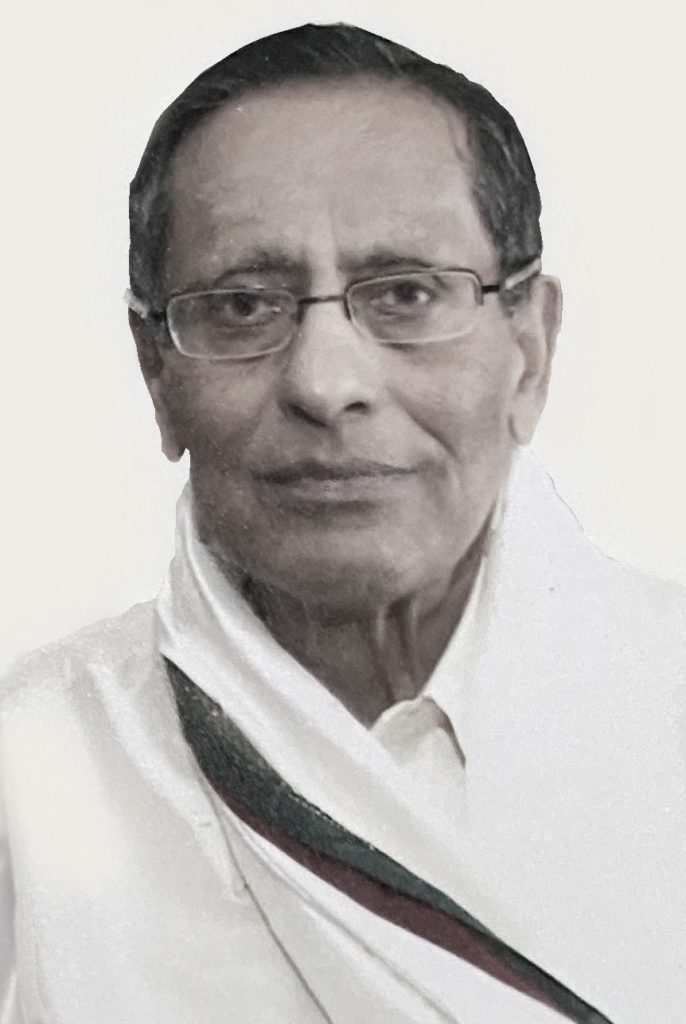
Tandaveswara (Tandav) Subramanyam Magge was born in Mysore, India on March 1,1932 to Hosakote Seethalakshamma and Subramanyam N. Magge. Tandav was the second of five children. His sisters Krishnaveni and Shashi are now deceased; and Tandav now is survived by his younger brothers Natesh and Shankar. When Tandav was 15, his father passed away and his brother-in-law M.R. Lakshminarayana stepped in to raise him and take care of his education and upbringing.
After completing his Bachelor of Science and Bachelor of Engineering degrees from the University of Mysore, Tandav came to the U.S. in 1961 to continue his education and join his brother. He had a very special bond with his brothers and sisters’ children and their families. As such, he worked very hard to bring the next generation of the family to join him in America.
Tandav received a master’s degree in industrial engineering from New York University and a master’s in mechanical engineering from Northeastern University. He worked at Curtiswright and General Electric for over 12 years designing aircraft engines. He then held a long and distinguished career for over 35 years at Westinghouse Electric Company in Pittsburgh, before retiring in 2012.
He was dedicated to his wife of 65 years, Susheela, as well as their children — Lakshmi an internist (and husband Ramesh, a cardiologist), Keshav, a plastic surgeon (married to Monica, a Marketing consultant), and Sandya, a financial services executive (married to Ketan, a lawyer).
His daughter, Lakshmi, was tirelessly dedicated to her father’s medical care, serving as his physician for over 30 years. He adored his grandchildren Anita, Ashwin, Lila, Veda, Zane, and great grandson, Niam. He was able to meet his newest grandson, Rohan, shortly before he passed away.
Tandav was grateful for his Pittsburgh community of friends and supporters. He was a dedicated/hardcore fan of all Pittsburgh sports including football, baseball and hockey. He passed away at his home on the night of July 24th with his family by his side. He will forever be missed, but his legacy will never be forgotten. — Submitted by Mr. Tandav Magge’s loving family members
Home:
All Elections — Even Presidential Ones — are Local
Posted by admin in January 2021, Past issues on December 29, 2020
The Polarized Voting Patterns Only Sharpened in 2020
By Kollengode S Venkataraman
In twelve presidential elections prior to 2016, Pennsylvania voted Democratic in eight — Humphrey (1968), Carter (1976), Clinton twice (1992, 1996), Al Gore (2000), John Kerry (2004), and Obama twice (2008 and 2012); and Republican in four (Nixon in 1972, twice for Reagan in 1980 and 84, and for George Bush in 1988). The state voted Democratic in all the previous six presidential elections with a comfortable margin of well over 100,000 votes. So, even though we are socially and culturally conservative, politically we are left-leaning in the aggregate. In 2016 we chose President Trump with a thin margin of 46,000 votes.
So, in 2020, for both Democrats and Republicans, Pennsylvania was a must-win state to hit the magic 270 number in the electoral votes. Crucial for GOP for retaining the White House for four more year, and for Democrats, for dislodging the divisive incumbent. In American politics, retaining is lot easier than dislodging. No wonder, during this summer/fall, I received over 100 political phone calls, more of them from Democrats. Because of the Covid Pandemic, the primary season was subdued; no made-for TV jingoistic nominating conventions; no campaign rallies in summer/fall.
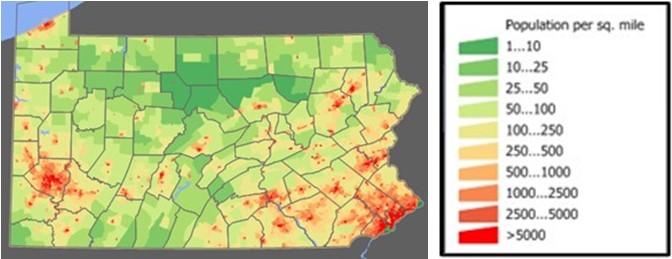
Opinion makers from both Right and Left told us that the country was sharply polarized politically as never before — between voters in densely populated urban areas and sparsely populated countryside; and between the college-educated and those without college degrees.
In the US, while the densely populated demographically diverse urban clusters are heavily “Blue,†sparsely populated relatively homogeneous rural counties are bright “Red,†with suburbs falling in between with a strong GOP streak. See the image above on the population density of Pennsylvania. Pennsylvania is typical on this measure.
As shown in the map shown below major urban centers voted Democratic, while rural counties voted for Trump in the 2020 elections. But Trump’s polarizing, shrill rhetoric and mishandling of the pandemic, many believed, would make the college-educated, white-collar suburban voters to go for Biden in large numbers, making it easy for him to defeat Trump. At least, that is how I read the media coverage.
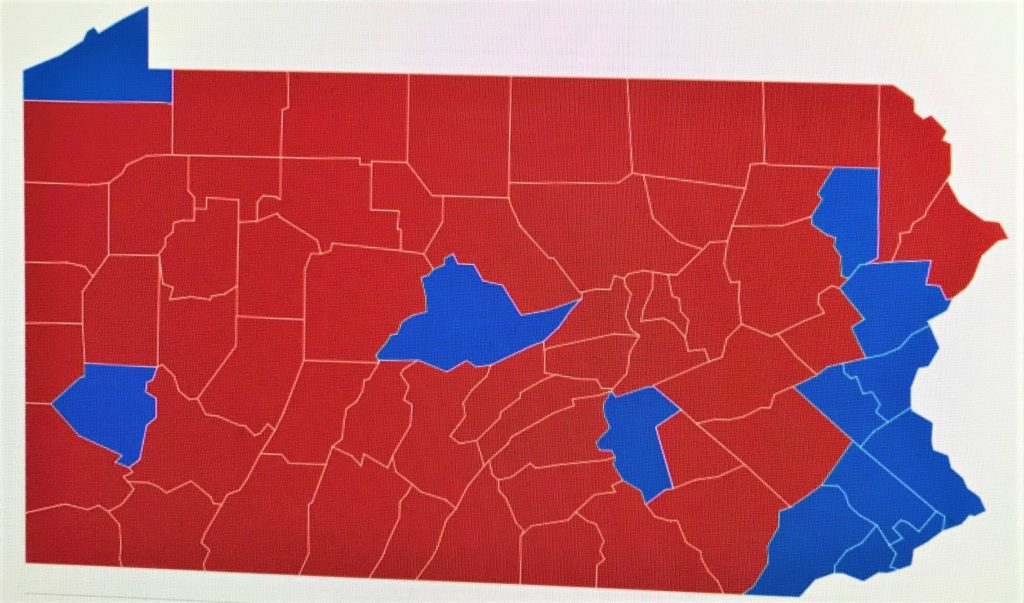
I live in Westmoreland County, adjacent to Allegheny County (which has Pittsburgh at its center). So, I compared the votes cast in counties around Pittsburgh in the 2016 and 2020 presidential elections, looking for a trend of suburban voters switching to Biden. What I saw surprised me. The bar chart below shows how Allegheny County voted in the last two presidential elections favoring the Democrats. While Republicans received ~255,000 in 2016, they got ~285,000 in 2020. But Democrats did much better: ~360,000 in 2016 vs.~430,000 in 2020). (numbers rounded to the nearest ‘000)
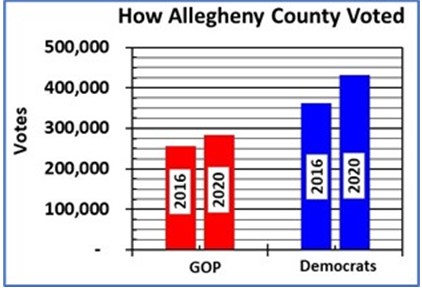
The bar chart below shows how the neighboring counties voted. All the aggressive campaigning by both the Democrats and the GOP folks had the desired effect. In all the counties around Pittsburgh, compared to 2016, both Republicans and Democrats got more votes.
In addition, as the table further below titled “Westmoreland County” shows, in Westmoreland County, in both 2016 and 2020 Trump got almost the same number of more votes — 56,000 in 2016, and 57,000 in 2020 — than his Democratic opponent. The change in the voting pattern favoring Democrats was small (1.6%) between 2016 and 2020, and there was no windfall shift favoring Democrats.
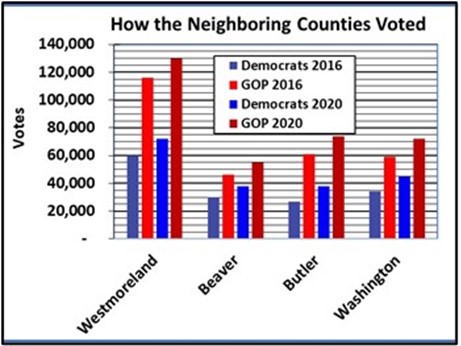
That is, Westmoreland County is still heavily Republican, Covid or No Covid, with almost 2:1 split favoring the GOP as before. This is despite the four years of Trump’s shrill rhetoric and lies, and despite his illogical approach to the pandemic ignoring all the advice from public health officials. This trend was seen in all suburban counties as shown in the bar chart on the side. While both parties increased their votes, the suburban counties continue to be heavily Republican in terms the vote split.
How the State as a Whole Voted: The table further below titled “PA State-Wide” compares the total votes for the entire Commonwealth of Pennsylvania in 2016 and 2020 elections. Again, here too, both parties got more votes for themselves in 2020 compared to what they got for 2016. In 2020, Republicans got 489,000 more votes (3,460.000 – 2,971,000) than what they got in 2016. Democrats did even better on this, getting 452,000 more votes in 2020 compared to 2016, with more votes coming from urban areas around Pittsburgh, Philadelphia, Harrisburg, Allentown, and State College. The net result of this aggressive state-wide campaigning resulted in Biden getting 82,000 more votes than Trump, thus bagging the crucial 20 delegates.
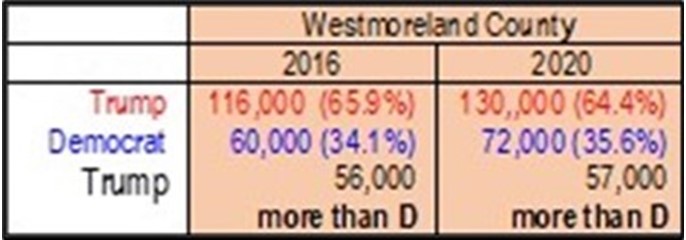
The contrasts in the voting patterns between the densely populated demographically diverse urban Allegheny County and the neighboring sparsely populated counties, shown in the two bar graphs above stand out. The urban areas favor Democrats, with the suburban counties heavily favoring Republican. This trend is the same in other urban areas such as Philadelphia, Harrisburg, State College, and Allentown. Sparsely populated and demographically homogeneous rural counties are even more sharply Republican. The (in)famous quote attributed to James Carville, “Pennsylvania is Philadelphia [in the east] and Pittsburgh [in the west] at the ends, with Alabama in between,†has not changed one bit in the last 30 years, even with Covid-19 and even with Trump in the White Hose.
This Urban-Suburban-Rural divide is an enduring trend all across the 50 states in the US. This is worrisome. Under democracy, nation-states so sharply polarized are difficult to govern. Deeply entrenched suspicion and vested interests make compromises difficult.
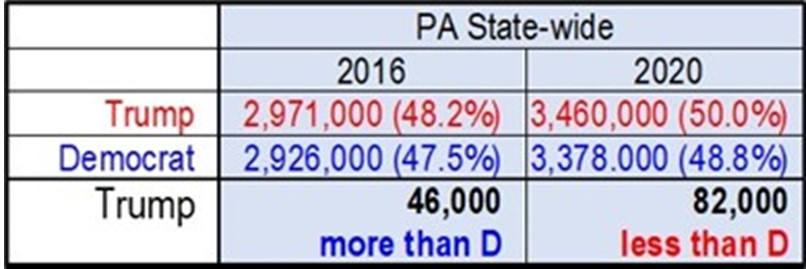
One glaring example of this vested interest was how the GOP-controlled state legislature in Harrisburg shamelessly drew and re-drew the maps for the Congressional districts favoring the GOP so that they got a 13/5 split in the Congressional delegation. This was despite the state as a whole has been voting 45:55 split between the two parties in presidential elections. Three years ago, the Commonwealth High Court had to intervene to redraw the congressional districts to make it more representative. After this, in the last two elections, the delegate split between GOP and Democrats is 9/9, more reflective of the state’s voting pattern.
Campaigns are fought from ideological extremes with simplistic and contrasting slogans that can be fitted into bumper stickers and placards. However, governing is possible only from somewhere in the middle, with the necessity and willingness to make compromises, which are always anathema to ideologues on both sides. Sadly, such political polarization all across the nation has led to social and cultural polarization as well. Already, Urban, Suburban and Rural Americas live in their own isolated and insulated silos of sharply different value systems, priorities and perceptions with very little interactions among each other, with mutual condescension and disdain. This often morphs into mutual animosity towards each other when taxation and resources allocations are debated and legislated by state assemblies, making governing more difficult. END
Home:
CCAC Creatively Responds to the Pandemic
Posted by admin in January 2021, Past issues on December 29, 2020
By Srujana Kanjula, Wexford, PA
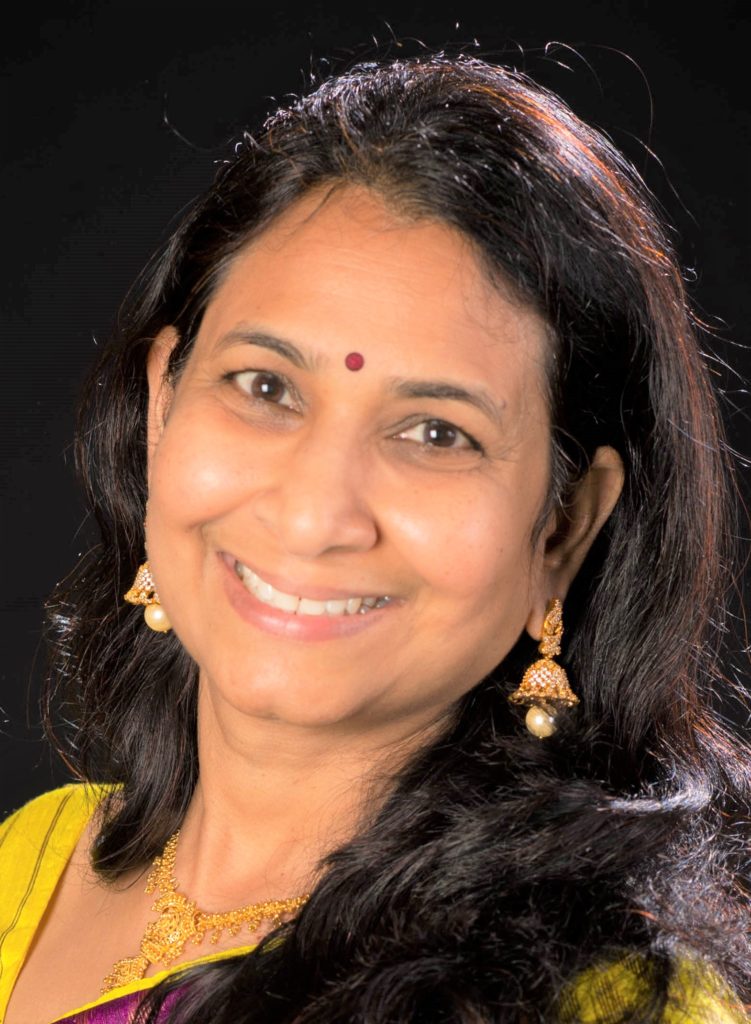
Editor’s Note: Prof. Srujana Kanjula, a full-time faculty at the Community College of Allegheny County (CCAC), shares her experience and observations during the COVID-19 pandemic as CCAC continues with its mission in teaching. Community colleges, unlike regular big-banner universities, have unique challenges, opportunities — and responsibilities — for attracting students to their programs. Through the Covid pandemic CCAC manages to deliver quality education to its students using creatively tailored online and virtual classes.
The COVID-19 pandemic disrupted all educational institutions, and CCAC is no exception. CCAC modified its operations, initially closing all facilities, and extending support to the community. When the region faced PPE shortages, we donated hundreds of gloves, isolation gowns, and masks to frontline health care professionals.
CCAC quickly converted hundreds of courses from in-person to remote. Allison Barash, my colleague and a professor of psychology, told me: “When CCAC abruptly closed, I wondered how I could transition from in-person to remote delivery. Then CCAC moved up the spring break giving us time to get up to speed, and provided the faculty a plethora of online training sessions. I liked learning remote teaching techniques. I am facile with Zoom now. Surprisingly, attendance was good, and students enjoyed my creativity with visuals, polls, and breakout rooms.â€
The economic challenges were many, but the college administration ensured that adequate finances are available to continue delivering quality instruction with many supportive services. CCAC provided laptops to over 250 faculty members. The college also received funding through the federal government’s CARES (The Coronavirus Aid, Relief, and Economic Security) Act, which helped combat fiscal challenges. As of 1st October, this funding helped 6500 students with $500 grants. The CCAC Educational Foundation awarded $200,000 in scholarships to 267 students, emergency funds to 34 students, and distributed laptops to over 200 students. All these were done within a short span of time.
Tyler Anderson, a digital design student says, “I’m grateful to CCAC for giving me a laptop to continue my education in digital design without interruption as I didn’t have to worry about my pieces looking inconsistent. This shows that CCAC cares about students’ success!†.
Another student, Ashika Richardson elaborated, “As a first-year student, I was nervous, especially in a virtual setting. But CCAC gave help with on-line services and tech support to accommodate all my registration and academic needs. My professors made my semester academically enriching and my experience invigorating.â€
In addition to teaching, I personally advise the World Cultures Club. In spite of the college closing, we had 15 new students join the club, and we successfully organized virtual events on Hispanic Heritage, Interfaith, Racial Justice, Indian Classical Dances, and on the 2020 elections.
Maxine Russo, another freshman, explained, “Joining the World Cultures Club gave me opportunities to interact with the college community and practice my public speaking and problem solving skills. I could participate in discussions on various cultural and political topics via Zoom and learn from other’s perspectives and experiences. As an organizer, I introduced guest speakers, moderated questions, helped with crowd control, and shared my insights. As a student interested in going into politics, I learned how to be professionally civil while dealing with problems. This club helped me come out of my shell and thrive.â€
Ashika remarked, “I served as a panelist in the virtual discussion on Understanding Racial Disparities in 2020. As a Jamaican student living in America, I got the opportunity to share my international perspective on racism. During this difficult time, CCAC created platforms for students to engage in meaningful conversations.â€
As the enrollment has decreased due to pandemic and economic downturn, CCAC is preparing to provide more certificates and credentialing programs along with general workforce development offerings. This is intended to help those individuals searching for new career opportunities and education credentials.
Prof Barash rightly concluded, “I give CCAC tremendous credit for being pro-active during this challenging time, keeping us safe, and preparing the faculty so we could give our students the best possible educational experience under extraordinary circumstances.†.END
Home:
Obituary: Nagabhushanam Nunna (1939 – September 21, 2020)
Posted by admin in January 2021, Past issues on December 29, 2020
By G. Paul Manoharan, Upper St. Clair, PA gopalsamy.manoharan@stifel.com
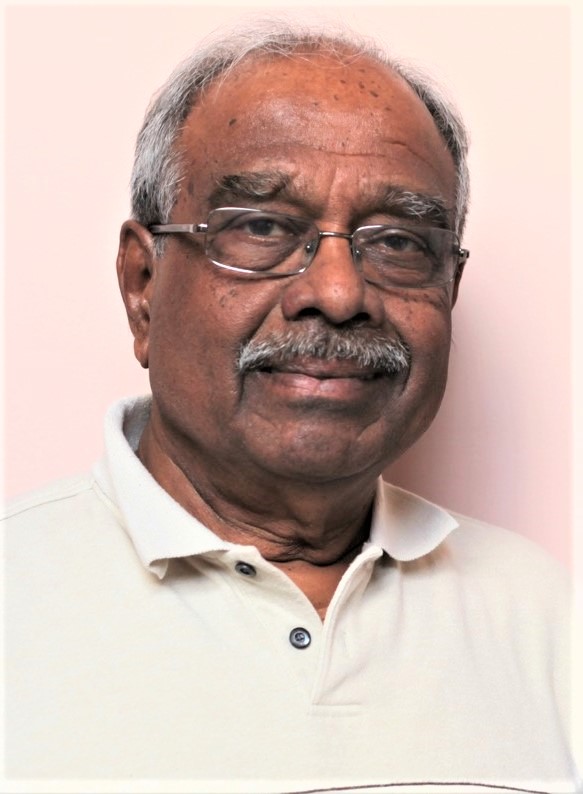
Dr. Nagabhushanam G. Nunna, known simply as Bhushan to his contemporaries, and as Nunna-Garu for people from the Andhra Pradesh, passed away peacefully on Monday, September 21, 2020. He was a resident of the Pittsburgh area for nearly five decades and a pillar of the Indian American Community. He leaves behind Dr. Sitalakshmi, his beloved wife of 56 years of marriage, his four daughters — Jyothi Jayaraman, Madhavi Rubbo, Jyothsna Nunna, and Manjula Evans — who he referred to as “my four angels,†six grandchildren, an extended family of relatives, and a large number of friends in the Indian American community. Bhushan’s efforts in promoting classical Indian performing arts and his pioneering leadership in establishing an authentic Hindu Temple in Pittsburgh enriched all our lives. Elders of the Indian community in North America acknowledge him for this service simply because fifty years ago, we were not as resourceful as we are today.
My wife Mani and I first met Bhushan socially in 1971. We got to know him more at the Hindu Jain Temple in Monroeville, especially during “The Conflict.†We worked with him during the formation of Sri Venkateswara Temple and for over forty years since then. Over the years, my admiration for him had grown for his integrity, his attention to details, and his courage to fight for things he believed in, even if it was not popular.
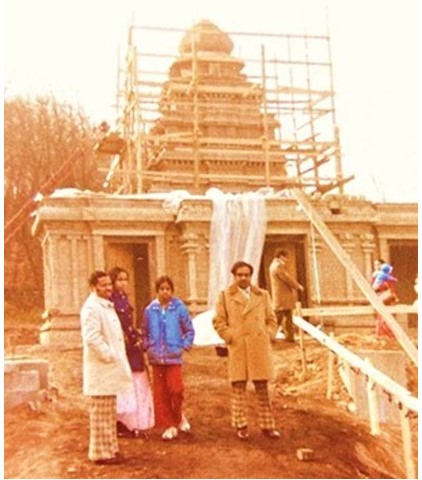
Nunna was born in 1939 in Kadapa, Andhra Pradesh and graduated from the Manipal Medical College. He married Dr. Sitalakshmi in 1964. He came to New York in 1965, himself first. His wife joined him later.
Bhushan started residency in New York in 1965, followed by fellowships at UPMC in Pittsburgh. In those nascent days of Indian community, Bhushan was one of the first to venture into and succeed in private practice in Butler in 1972. He inspired other Indian physicians to go into private practice. He later joined the staff of the Butler Memorial Hospital, from where he retired in 2001.
Bhushan, in early 1970s, encouraged Ms. Jaya Mani of Slippery Rock, a new immigrant from India trained in Bharatanatyam, to teach dance for children here. Jaya was married to Dr. S.B. Mani, a teaching faculty at the Slippery Rock University (now retired).
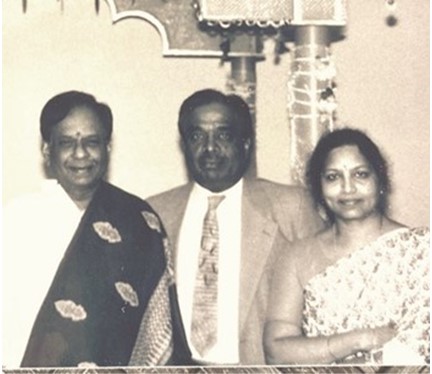
Nunna threw open the basement of his house in Butler for the dance class, and pretty soon during weekends — sometimes even during week-days — his home was filled with students learning dance, and veena lessons offered by his wife, an established veena artist. The dance classes became so popular that they were moved to the basement of an Indian grocery store in Squirrel Hill. It has been growing ever since and has enriched the lives of countless youngsters here. Bhushan’s two older daughters, Jyothi and Madhavi, were the first to have their Bharatanatyam Arangetram in Pittsburgh. Thus, the performance arts scene in Pittsburgh started in Bhushan’s basement. With passion and deep interest in Indian classical performing arts, the Nunnas hosted many visiting artistes from India.
Bhushan was one of the three incorporators of Sri Venkateswara Temple at its inception. It took considerable efforts by Bhushan to first convince Indians in Pittsburgh the need for a Hindu temple, and then persuade the Tirumala Tirupati Devasthanam officers for their help in building an authentic Hindu temple here. The Tirupati officials were skeptical of the idea after the failure to build a Venkateswara Temple as part of the Monroeville Hindu Jain Temple. Eventually, they wholeheartedly embraced the idea for the S.V.Temple here in Pittsburgh. The tie up with the Tirupati temple was invaluable in the formative years.
Bhushan was the first Chairman of the Board of Trustees of the Temple and he continued to serve the Temple to the fullest extent he could in official and other capacities. His leadership and unflailing support for the causes he believed in helped in establishing the Temple as a unique institution for Hindus in North America.
Echoing similar thoughts, Saraswathi and Thippeswamy Channapati of Butler, who knew the Nunnas for decades, add: “Nunna-Garu, an attentive and compassionate physician was busy, and still found time for community work, like revising the bylaws for Butler Memorial Hospital. He applied the same energy and attention-to-details in establishing the Sri Venkateswara Temple. In the early days, he himself videotaped hundreds of hours of cultural programs of children and professionals alike at the temple. He was so committed to the temple that even during his final days, he passionately advocated the need for changes and reform. Dr. Nunna believed in putting principles over personal relationships.â€
The cause of his death was complications following open-heart surgery. Dr. Nunna received a traditional Hindu cremation service in Butler, with Shri Venkatachari from S.V.Temple as the officiating priest. Bhushan’s accomplishments are many more. He surely enriched the lives of everyone around here in the early days. God Bless him. END
Home:
The Crazy National Elections of the First World
Posted by admin in January 2021, Past issues on December 29, 2020
By Kollengode S Venkataraman
The US, the First World’s leader, routinely sends monitors to oversee elections in the wretched Third World, to educate them on democracy and peaceful transfer of power, and to prevent voter intimidation and ballot box stealing. Now, the president of the leader of the First World, Donald Trump, has been characterizing the 2020 elections in which he himself is the candidate, using the same terms, just because he lost. And lost it big, both in popular votes and the mysterious electoral college votes.
Donald Trump, already a global laughingstock for quite some time, also turned the GOP that nominated him into a grotesque caricature, and a willing accomplice in his shenanigans. Republicans used to brag about their righteousness rooted in their Judeo-Christian heritage, personal rectitude, fiscal responsibility, and ethical probity. Their astounding hypocrisy in acquiescing to Trump, who is the antithesis to these values, is embarrassing even to some of GOP’s own leaders. In this long drawn tragicomedy, the US lost some of its sheen and moral high ground on these matters.
The nine unelected High Priests in black gowns unanimously refusing to put up with Trump’s pranks are the saving grace in this drama. Relish the irony here: six of them are appointed by Republican presidents,
If election fraud was pervasive against the Republicans, how is that they gained more seats in the Congress, and GOP’s grip in state legislatures is intact? The rank-and-file Republicans may not accept the nation rejecting Donald Trump in the elections, both as a person and as president. That is how Trump built up his supporters appealing to their insecurities, fears, and racial/religious/ethnic prejudices.
What is embarrassing is that not many in the GOP leadership stood up to their president even after he lost big in both popular votes and the electoral college votes.
As many suspect, if foreign hands (China, Russia, their surrogates and others) were at work for weakening the US, they got their job done with great finesse by damaging it from inside with very little cost to themselves.
Now it will take quite some time and lot of diplomatic skills for President Biden to regain the lost ground for the US, as he gets ready to fight the Covid-19 pandemic on multiple fronts. END
Home:
Dump the Trump-Pence Ticket
Posted by admin in Oct Jul Apr 2020, Past issues on October 4, 2020
Arun D. Jatkar, Monroeville, PA .
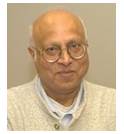
While on WhatsApp with friends in India, I coined a slogan, Dil pukare baram-bar, Modiji ka jay-jay-kar! But when asked if I will ever say, Phir ek bar, Trump Sarkar, my answer was an emphatic No.
Having made a conscious choice to become a US citizen years ago, I feel I ought to vote for someone who will work for the good of America and Americans, not for someone who simply mouths slogans like “Make America Great Again,†and then, in the same breath tells Americans to get rid of the ballot. Everyone knows the serious threat posed by his psychopathic and equivocating “musings†that will derail a smooth transfer of power, if he loses in the presidential elections this fall.
Years ago, I had to rely on Cobra for myself and my wife for eighteen months; and when that ran out, had to go without Cobra for another eighteen more months before becoming eligible for Medicare. So, I know first-hand what it is like to be out in the cold with pre-existing health conditions. So, I just CANNOT vote for a nominee who is obsessed with the thought of abolishing the Affordable Care Act. And now, with social security as my major financial lifeline, I just CANNOT vote for its callous, remorseless disappearance. In addition,
— Do I want to see a government-promoted, nakedly racist policy of disenfranchising the citizens of color? No!
— Do I stand for the insults heaped upon our sons and daughters who put their lives on the line for defending America? No!
— Do I want to go along with the maniacal policy of hoping for herd immunity in the midst of the current pandemic? Hell, No!
— Do I want to vote for a man who stands safely away from unmasked crowds and tells them that the fear of Covid-19 is a hoax? No!
— Will I vote for a man who values Putin’s words more than the findings of our own intelligence agencies on matters of national security? No!
— Do I want to vote for a man who wantonly denies climate change and says, “Science does not knowâ€? No!
— Do I want to vote for a man who is hellbent upon permanently silencing the voices of pro-choice women? No!
— Do I want to vote for a man who is determined to deny the LGBTQ community the right to live like other human beings? No!
So, I’ve made up my mind: Dump the Trump-Pence Ticket! END$$
Home:
Diwali at the Children’s Museum Last Year
Posted by admin in Oct Jul Apr 2020, Past issues on October 4, 2020
By Juginder Luthra, Weirton, WV
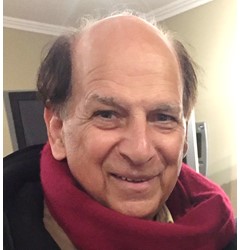
The tapestry of Pittsburgh is changing. More and more threads of Indian Americans — like our customs, foods and festivals — are getting woven into the Pittsburgh community. In this, we have come a long way from a time about forty years ago, when a well-educated resident of Pittsburgh asked us, “Do they have festivals in India?†We told him about the numerous festivals and the meaning behind each one. Only one person became educated with our answer.
A community leader among us, Mrs. Krishna Sharma, last year made one more institution become more familiar with India to a higher level. Sometime back, she had acquired an old church in Carnegie, converting it into the India Community Center, now known as ICC. Last October, she collaborated the Diwali activities at the ICC with the Children’s Museum of Pittsburgh. On October 19, 2019 India’s auspicious Diwali was celebrated, for the first time, at the Children Museum.
The flyer made by the Museum to promote the event included the following lines: This event was made possible by the India Community Center. Special thanks to our event chair Krishna Sharma.
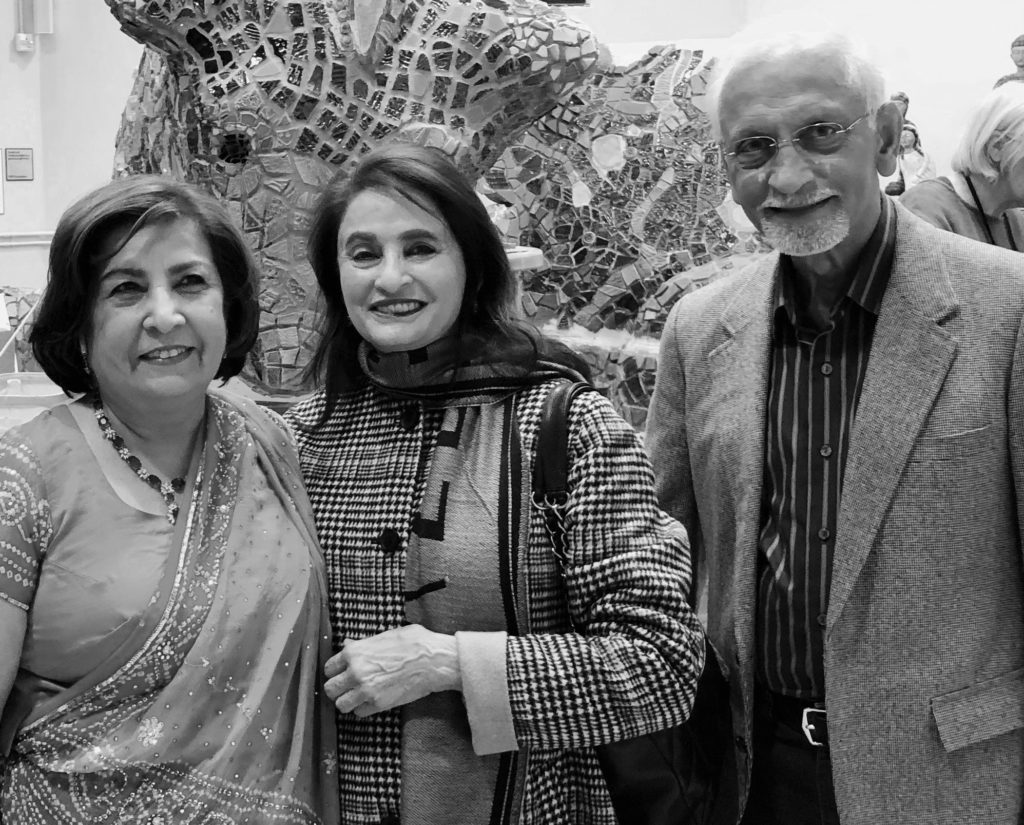
In spite of serious family issues, Krishna gave her time and efforts for the celebration of Diwali at the Children’s Museum. The event was set on three floors of the Museum Lab. For a token ticket of $5, hundreds of children and adults, a mix of mainstream Americans and Indian Americans, enjoyed Indian snacks provided by Cafe Delhi. A large traditional rangoli designed and colored by Krishna Sharma and colored by Krishna greeted visitors at the entrance.
Children colored diyas (clay lamps), learned the rangoli art, and had henna painted on their hands. Sheena Chopra of Weirton, a well-known singer, now living in Pittsburgh, rendered the National Anthems. Against a backdrop of Indian saris decorating the stage, students of Guiding Stars Production performed traditional Indian dances. Their teacher, Sonia, choreographed the dances for the event. END$$
Home:
Air Travel During the Pandemic
Posted by admin in Oct Jul Apr 2020, Past issues on October 4, 2020
By Manjeri Raman, Savannah, GA
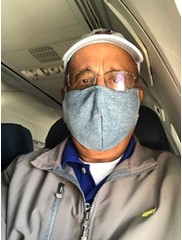
My wife Krishna and I traveled to Seattle in mid-July after postponing our tickets twice — in early March and then in June — thinking that the Covid-19 situation would improve. Surprisingly, Delta did not charge us a change fee. The pandemic showed no sign of abating. We took our chances and traveled, since we needed to go to see our son there.
0ur check-in experience at the empty Savannah airport was smooth, with everyone wearing masks and gloves. Savannah being a small airport, the TSA agents were friendly and considerate about allowing food in the hand baggage. The waiting area at the gates was set up for social distancing with alternate seats clearly marked. Boarding was strictly by row numbers, with time allowed for social distancing. Our flights first to Atlanta and then to Seattle were about a little over half full.

As we entered the plane, flight attendants greeted us with a Ziploc bag with two small snack bags, bottled water and a sanitizing wipe. They offered masks if you needed them. Everyone was expected to wear the mask during the entire flight except when eating. All the passengers complied. The seats and the seat-back trays were clean and you could use the wipes to clean them further!
Atlanta airport, one of the busiest in the world, with seven con-courses, was a ghost town with just a handful of passengers walking around. It was quite an eerie experience! Very few business travelers. Most like us, were traveling out of necessity.

Our layover in Atlanta was about an hour. In the long flight to Seattle, flight attendants cleaned the bathrooms frequently. No cart service of any kind – only bottled water was served – and if you ordered drinks, they brought it to your seat. They did not want to handle either cash or credit cards. Everyone brought food and the trash was picked up frequently.
When we landed in Seattle, another busy airport, ours was the only plane to land at that time, and within minutes we picked up our baggage and met our son outside! Again, this was quite different from our usual trips to Seattle.
We had to cut short our trip by a week, and when I called Delta, they were accommodative and again changed my flights without any fee. I was surprised to get a small refund, as the base fare for the date was lower than what we had paid.
The return flights to Atlanta and Savannah were a replay of the outbound flights. This time we had over a two-hour layover in Atlanta. The food court was partially open, and we had our dinner with mask and social distancing guidelines.
Overall, Delta did a great job under difficult circumstances. I was surprised however that not a single question was asked about Covid-related symptoms nor were our temperatures checked. I thought since we were traveling from the state of Georgia, ruled by an irresponsible governor, there would be some checks or questions. I also expected to fill out our destination address for contact tracing. None of that happened!
We were traveling as before, with no restrictions or questions. This is quite different from India and other countries, where serious efforts are underway to make sure that the Covid virus does not spread due to unrestricted or unchecked travel. END$$
Home:
Our June 2020 BLM Rally at Flagstaff Hill
Posted by admin in Oct Jul Apr 2020, Past issues on October 4, 2020
By Pallavi Muluk, Pittsburgh, PA
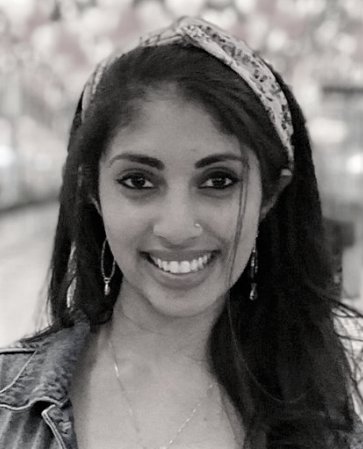
Editor’s Note: Pallavi Muluk is a senior at the University of Pittsburgh and will be matriculating to University of Pittsburgh Medical School after she graduates in April 2021. She is extremely passionate about social justice matters impacting minorities in our country and helped to establish the youth organization South Asians for Change this summer to confront these issues.
Most of us are well aware of racism toward Black people in America. However, too often we performatively mourn the injustices, become overwhelmed by the enormity of the problem, conclude that the issue does not directly affect us, and move on. After all, we’re not hurting anyone, right?
Actually, I would argue that maintaining our decades-long silence does more to perpetuate racist ideologies than blatant acts of prejudice.
On Saturday, June 13th, over 300 members of the Pittsburgh community came together at Flagstaff Hill to celebrate the Black voices in our neighborhoods. Organized by South Asian youth and adults from South Asians for Change (https://www.saforchange.com/) and Pittsburgh Indian Community and Friends, the gathering highlighted the pervasive racism in our society and finally showed our allyship to the cause.
We often forget that if not for Black leaders like Martin Luther King Jr., Rosa Parks, and Malcom X, the Immigration Act of 1965 would never have been passed and we wouldn’t have stepped foot into this country. So how can we now turn a blind eye to the trauma of the Black community? Why do we perpetuate the “model minority myth†and allow the Blacks to suffer the consequences? By now we must know that ignorance is not bliss. When Black people cannot go jogging, hold a bag of skittles, sleep peacefully after a long day saving lives, eat ice cream, or even stand in their own backyards, there is no place for our inaction and silence.\
On June 13th, we listened to a passionate call to action from the Rev. Dr. Darryl Canady; the experiences of Shirley Douglas; and much needed advice on where to start from Lance Hyde and Nicholas Anglin. The beautiful music of the Rodman Street Baptist Church Choir reminded us of everything, art and otherwise, on how the Black community has enriched our life here
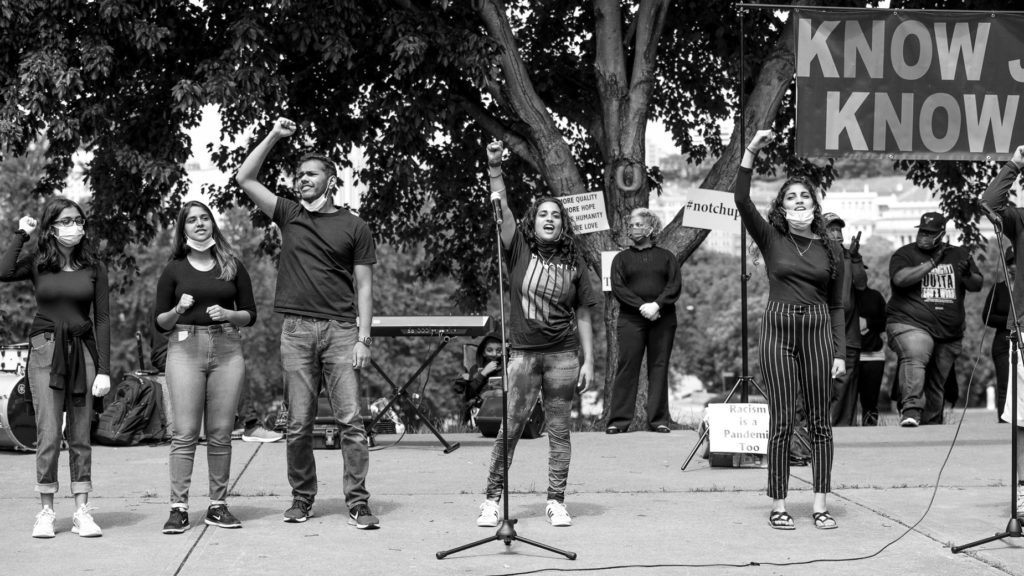
When we chanted the names of George Floyd, Ahmaud Arbery, Breonna Taylor, and Traeyvon Martin, we reminded ourselves why this fight is necessary. Most of all, we learned how much more needs to be done.
While we as South Asians strive to understand the realities of systemic racism, we must accept that being a minority in America does not make us immune to being racist and prejudiced. It is undoubtedly an uncomfortable topic, but instead of saying, “There’s nothing I can do,†sit in that discomfort and ask, “What can I do?â€
Minimally, exercise your constitutional right to vote this November to elect a leader who has a semblance of compassion and who does not bring out the very worst in our country. Take five minutes today to learn something new about the reality of Black people, and tomorrow take ten minutes to figure out what you’re going to do about it. And the following day get started.
Books to read:
White Fragility by Robin DiAngelo
How to be an Anti-Racist by Ibram X. Kendi
Between the World and Me by Ta-Nehisi Coates
Links:
Systemic Racism Explained (act.tv)
How to Be an Ally if You Are a Person with Privilege (Frances E.
Kendall, Ph.D. © 2003)
Editor: The graphics are from South Asians for Change. END$$
Home:
The Indian Community Responds to the Food Crisis for Needy Families in the Pandemic
Posted by admin in Oct Jul Apr 2020, Past issues on October 4, 2020
By Suresh Ramanathan, a PICAF Volunteer
Long car lines this spring that stretched over a mile outside the Greater Pittsburgh Community Food Bank (Food Bank) with wait times of up to five hours brought national attention to our region. The increasing unemployment in Pennsylvania combined with numerous business closures and the socially crippling coronavirus brought about a perfect storm that debilitated families that had not previously experienced food insecurity. It was worse for other families that were already suffering and did not have any transportation to get to these distribution centers!
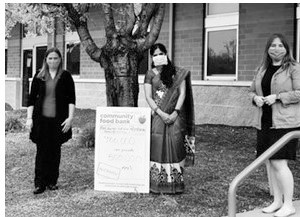
The Pittsburgh Indian Community and Friends (PICAF) had an existing partnership with the Food Bank as we had worked with them to improve a breakfast menu for school children so that they were nutritionally charged and ready to learn!
Even before PICAF reached out to the Food Bank, individual donors from the Indian Community had already donated to the food bank. However, each of you reading this should feel good that Indian families in our region stepped up and helped Pittsburgh Indian Community and Friends (PICAF) raise over $100,000 in a matter of weeks!
As with all our partners, 100% of all that we raised goes to the nonprofits. The Food Bank worked with us to make sure 100% of what we gave them went to the program and not to overhead. Further a dollar-to-dollar match from 84 Lumber and Nemacolin Woodlands allowed us to double the amount and thereby double the number of meals delivered to needy families!
On Thursday, April 23rd, 2020 the Indian Community had a combined check presentation at the Greater Pittsburgh Community Food Bank with $5,000 from Hindu Jain Temple, $25,000 from the S.V. Temple and $100,000 from Pittsburgh Indian Community and Friends (that includes a significant contribution from Chinmaya Mission and S.V. Temple). Dr. Visala Muluk represented Chinmaya Mission and the Pittsburgh Indian Community and Friends, Dr. Linganna, Secretary of S.V. Temple and Jayesh Selokar of Hindu Jain Temple.
The combined total was $130,000 that would have resulted in 750,000 meals; but with the match we were able to deliver 1.5 million meals!
This year PIC5K has gone virtual. We are turning our attention to eradicating racial inequities in education! One of the projects we are investing in helps families with young children deal with cyber classes conducted by the Pittsburgh Public Schools. The OASIS project has established a neighborhood pod school that buses children to the pod and feeds and mentors them as they attend online classes from 9:00 am to 3:00 pm. PIC5K is raising funds this year to support an after-school program for these children focused on robotics and coding. Please visit www.pic5k.org and helps us facilitate children learning while their parents have time to earn. END$$
Home:
Obituary: Maxine Bruhns (1924 to July 2020)
Posted by admin in Oct Jul Apr 2020, Past issues on October 4, 2020
By Chandrika Rajagopal, College Station, TX
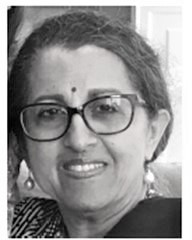
Editor’s Note: Chandrika Rajagopal lived in the Pittsburgh Metro area during the 1980s and 90s, and was part of the efforts to smooth out the teething troubles of the Indian American community in those challenging formative years. She was the founding chairperson of the Indian Nationality Room Committee from 1991-2000. She moved to Texas, in 1998.
Meeting Maxine Bruhns was an unforgettable experience. In May 1991, we met near a painting at Chancellor Wesley Posvar’s residence on the Pitt campus. An elegantly dressed lady shared with me details about the artist while I was admiring the painting’s wintry scene. She was Maxine Bruhns.
After our introductions, the first question that flew out of my mouth was, “Why is there no Indian Nationality Room?†Maxine explained that these unique rooms are built by the local immigrant communities, who raised funds to build their rooms to honor their ancestries and countries of origin. She promptly invited me to head up a committee.
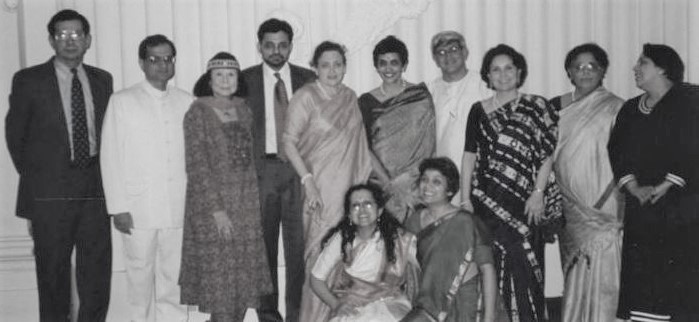
That is how the Indian Nationality Room’s destiny was set in motion. While forming our committee, Maxine was a great source of inspiration as she motivated us by sharing stories about how the other nationality rooms grew and developed. I was struck by her interests in various cultures, her indefatigable energy and her single-minded devotion to the Nationality Rooms program. The spirit of Ruth Crawford Mitchell was alive and well in Maxine!
From the beginning, the aim of our committee — at the time, consisting of Anu Reddy, Deepak Wadhwani, Saroj Bahl and myself — was to highlight India’s incredible unity and diversity. We showcased India’s cultures through art, dance, and music by hosting fundraising programs. Maxine attended all of them, dressed in strikingly colorful and culturally appropriate attire.
From beginning to end, she inspired us so much that we became the first Nationality Room committee to raise funds, design, build, and dedicate our room in under 8 years! While the kudos for this feat go to the generosity of our beloved Indian community, Maxine was the fairy godmother who shepherded us through the various steps over the years.
The culmination was the dedication in January 2000. When I suggested a typical Indian way of inaugurating anything new with ceremonial blessings, Maxine watched delightedly as the stunning room, designed by Deepak Wadhwani, was blessed by religious representatives from India’s religions: Hinduism, Jainism, Buddhism, Judaism, Christianity, Islam, Sikhism, and Zoroastrianism.
The official dedication at Heinz Chapel followed by a delicious dinner in the evening were memorable occasions graced by Chancellor Mark Nordenberg and Naresh Chandra, India’s Ambassador to the U.S.
What else can I say about the indomitable Maxine? I learned much: her dedication, devotion, love of and for life, her wealth of experience and her insatiable curiosity about new and different things. My move to Texas kept us in touch for over two decades as she updated me on the new rooms, scholarship programs, and personal matters. I never stopped admiring this West Virginia-born-and-raised gal who left her mark on Pittsburgh and, through the Nationality Rooms Program, the world.
Who could have ever imagined that a chance encounter over a painting would lead to the construction of a Nationality Room and a relationship that endured for decades?! Maxine passed away on July 17, 2020 in Pittsburgh. She was 96. Rest in peace, dear Maxi! END$$
Home:
Black Lives DO Matter — Do the Browns Care?
Posted by admin in Oct Jul Apr 2020, Past issues on October 4, 2020
By Deepak Kotwal, Pittsburgh, PA.

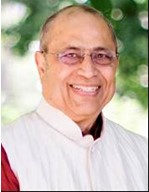
This is a common Hindi proverb meaning “The washerman’s dog neither belongs to the home nor the river-shore.†Even after living in the US for decades, many Indian immigrants and naturalized citizens feel they are “Indians†living here and “Americans†while visiting India.
The police killing of George Floyd, a Black man, in broad daylight by use of excess force in Minneapolis in May triggered Black Lives Matter (BLM) protests nationwide. Many whites joined, recognizing the systemic racism against African Americans. In this, where do the BROWNS — the immigrants from India — stand? Are we like the proverbial Washerman’s Dog? Since we are neither white nor black, do we feel it is not necessary to get involved? The BROWN youngsters here did not think so. For details, see Pallavi Muluk’s article on the BLM rally held in Oakland.
Indian Americans have done extremely well in the US due to their in-demand, marketable cerebral skills. Among the recent immigrant groups by country, Indian Americans have high incomes and net worth, primarily because of the skewed immigration policies of the US of letting in only people with cerebral skills. Claims that our success is due to our merit, hard work and American meritocracy are only partially true. We are the beneficiaries of two broad historical developments: a large economy and the Civil Rights struggle. We generally don’t recognize how we are benefitting from the latter.
Early English and other European arrivals to North America simply grabbed the land from the Native Americans, leading to genocide and driving the Native Americans into reservations. Slavery provided free labor of kidnapped and enslaved Africans. The concept of White Supremacy (AKA manifest destiny) was the essential intellectual underpinning.
Civil rights struggles followed. Even after the Civil War (1861-1865) ended with the Confederate States’ defeat and the abolition of slavery, Blacks were kept subjugated through Jim Crow laws, intimidation, and lynching. The Civil Rights Movement, led by Martin Luther King Jr, finally led to the 1964 Civil Rights Act. All later immigrants from India are the beneficiaries of the hard-won Civil Rights Act on housing, schooling, and employment.
One would think that the US would have welcomed immigrants in the expanding labor-short economy of the 19th and early 20th centuries. But the American attitude towards immigration was not only racist, but also anti-Catholic and anti-Jewish. It favored the Protestant White immigrants from Nordic countries. Various laws, such as the Chinese Exclusion Act, excluded Asian immigration. Naturally, in early 20th century, the number of Indians in the US was negligible. The few, mostly Sikhs from Punjab, working as laborers, faced racist attacks. An example is the 1907 Bellingham riots in Washington state to kick out Indians.
The game changer for Indians was the 1965 Immigration Act. It did away with the country-based quotas and preference for European immigrants. This act preferred immigrants with skills required for the US economy. The US was anxious to catch up technologically with the USSR after it launched Sputnik in 1957. The change was perfect for English-educated, highly skilled Indians when the Indian economy was not large enough to fully absorb them. Hence the in-flux of Indian graduate students in S&T, and doctors as residents in US hospitals after 1965.
The Civil Rights Movement and the enormously consequential 1964 Civil Rights Act made it easy for the later Asian immigrants. It integrated schools and housing, workplaces, labor unions, established the Equal Employment Opportunity Commission with its potential for lawsuits and did away with the overt Jim Crow segregation in the South.
Thus, we are the direct beneficiaries of the hard-won social changes brought about by the descendants of enslaved Blacks, without even being aware of it. So, we do need to support the continuing march by Blacks towards the eradication of racism. A few questions of self-examination are warranted here.
— What is our attitude towards African Americans? Are we unconsciously internalizing the White attitudes, thinking we are accepted here as “honorary†Whites?
— Do you know any African Americans you would call a friend?
— Do you sympathize with “colorism†in the Indian matrimonial ads? The ones where “wheatish†complexion is preferred.
— How would you feel if your son or daughter were dating/marrying an African American?
— If there is a BLM protest planned in your area, would you show up with your kids?
We owe this self-examination to ourselves, and also as a tribute to the activists who risk life and limb for progress that directly benefits us. Barrack Obama was the very first Black president — elected and then re-elected. Just remember: the choice of Kamala Harris as the VP candidate for the Democratic Party would have been impossible without the political struggle waged by the Native Blacks’ Civil Rights movement.
It is time for us to follow the lead of our youngsters:
For details, see Pallavi Muluk’s article on the BLM rally held in Oakland.
END$$
Home:
The Pittsburgh Patrika’s 25-year Trajectory
Posted by admin in Oct Jul Apr 2020, Past issues on October 4, 2020
By Kollengode S. and Premlata Venkataraman
Assessing the articles in The Patrika against the goal it set for itself (as detailed in this lead article), one can say, the magazine has met its objectives. You can access the other articles at www.pittsburghpatrika.com.
Unlike New York/NJ, DC/MD/Northern VA, and the Bay Area where hundreds of thousands of Indians live, barely 18,000 Indians live in the Pittsburgh Metro region (Southwestern Pennsylvania, the West Virginia Panhandle and Eastern Ohio). And yet, we have people among us contributing articles for the magazine. These writers take time from their busy careers as engineers, financial planners, teachers, physicians, dancers, musicians, and Hindu priests to express themselves. They have written poems, personal experiences, cynical observations on the desi lifestyles and contemporary issues, reviews of events in Indian performing and visual arts, humorous pieces, and many others.
These writers trust the integrity of the magazine, even when they do not always agree with the tone and contents of some of the articles. A big Thank You to these writers.
The magazine deliberately stayed away from the glossy filmi gossips, even though we received suggestions from well-meaning readers that these items would make the magazine more lively. Yet, the magazine has survived for these twenty-five years with your support.
Personally, publishing this magazine was both an outward journey, and an inward journey as well for us as we worked in our spare time seeking advertisers, interacting with writers in developing stories, and reviewing and finalizing manuscripts. Our interactions with people strengthened our cultural and spiritual moorings as liberal Hindus, as Indians, and now as American citizens.
Our ideas about our faith was reinforced when we went to the original texts and read on their several interpretations, which we shared with readers in many articles. It helped us to go back to India’s literary/spiritual traditions over three millennia in Sanskrit, Hindi, Kannada, Punjabi, and Tamil languages and place their refreshing relevance to our contemporary life — here and now — in these United States.
Laying out the magazine integrating stories with graphics and with advertisers’ artworks has been a challenge requiring great attention to details. All through these years, the magazine has been able to satisfy advertises and writers, while producing a reasonably well-edited and well-laid out product, four times a year for the past 25 years. END$$
Home:
The Business End of the Magazine
Posted by admin in Oct Jul Apr 2020, Past issues on October 4, 2020
By Kollengode S. and Prema Venkataraman
Printing and mailing the magazine for free was possible because of two reasons: First, we had full-time jobs that gave us a professional middle-class lifestyle. With this, we could divert the bulk of our spare time to the magazine. When people ask us how we do this with our full-time jobs, we have often replied them with a different question, “More than ‘How do we do it?’ we have been wondering ‘Why do we do this?’â€
Honestly, when we asked the same question ourselves, particularly while in the middle of a cash crunch to pay the bills, we never got an answer that made any economic sense. But then, as Christ says in the New Testament, “Man does not live by bread alone.â€
The second reason is more important. To retain our editorial independence, The Patrika deliberately has not sought financial or other kinds of support from any social, cultural, political, religious, corporate, or government entities. However, in the Free Market World, any business activity has a reason to exist only if it can stand on its own legs to pay all the bills. The Patrika owes a very big Thank You to all our advertisers — many of them repeat advertisers from Mainstream America and a few Indian businesses here as well. Our advertisers are the only reason the magazine has survived for twenty-five years. We acknowledge their support and trust in our integrity.
Without subscriptions, advertisements were the only source for us to meet the expenses — around $5,000 to $6,000 for each issue. These include the bare-bone expenses for a) printing and mailing the magazine; b) software updates essential for the magazine layout, address correction, and bulk mailing; and c) office supplies and incidentals and travel.
We also spend lots of time working with writers revising and finalizing stories, copyediting & proofreading the articles; and then on the layout of each issue sequencing the articles and advertisements.
As the lead article details, the Coronavirus stunned the finances for the magazine with advertisements vanishing in one stroke.
Thousands of businesses have shut down with tens of millions losing their jobs, and investors losing trillions of dollars. The hospitality and education industries — our mainstay among advertisers — were the worst hit.
It will take a long time for “normalcy†to return even after the pandemic is brought under control. Our life and lifestyle and work environments have already changed. And for sure, the new “normal,†when it returns, will be quite different from the one we left behind. The way we live and work; our ideas of what we mean by “success and wealth,†society, neighborhood, leisure and entertainment, travel and vacation, all will be quite different, hopefully for the better.
So, that is why an honest financial reckoning for the magazine became necessary. And that is why The Patrika seeks voluntary contributions of $20 or more from readers. We hope this is a temporary measure. Please remember, we have been mailing this magazine for free for 25 years, or 100 issues! If and when the economy recovers, we will definitely revisit this situation. Please note that your contribution is NOT tax-deductible since the magazine is not a tax-exempt enterprise.
You can make your volunteer subscription at this Gofundme site.
Or you can mail your check payable to:
The Pittsburgh Patrika, Inc. 4006 Holiday Park Dr., Murrysville, PA 15668.
END
Home:
An Appeal for Voluntary Subscription — The Day of Reckoning for The Pittsburgh Patrika
Posted by admin in Oct Jul Apr 2020, Past issues on October 4, 2020
By Kollengode S. Venkataraman, Editor and Publisher
The Coronavirus pandemic turned the lives of over six billion people upside down worldwide, devastating every segment. Even giant US businesses using the now-familiar “Too Big to Fail†argument, sought — and got — taxpayer-funded bailouts. There is a saying in Tamil,

Translation: “In the tornado, the kitchen grinding stone itself is flying in the air. What can peepul leaves do?†The Patrika is a peepul leaf sucked into the Coronavirus tornado.
“Day of Reckoning†is the phrase in the Bible referring to the Last Judgement. We use the phrase here not in the biblical sense, but in the literal sense, with “reckoning†to mean counting, as in “accounting.â€
You have been receiving the magazine for free for twenty-five years since 1995. In the midst of the Covid-19 pandemic, this is no longer possible. The pandemic wiped out the advertisements that paid for printing and mailing 1900 copies of the magazine for free every three months to readers around Pittsburgh. So, The Patrika is seeking voluntary subscriptions to continue to inform readers about what is going on in our midst.
When The Patrika started its journey twenty-five years ago, the lead article “Why This Newsletter?” began thus:
“The Pittsburgh Patrika is an experimental newsletter to reach people who trace their heritage to the Indian subcontinent, or who are curious about the people from there. This newsletter is a forum for airing and sharing your views, ideas, and even frustrations, on any topic. People from the Indian subcontinent have a diverse background, and yet, are so very alike. When we look through our patina of sophistication, we see that our pleasures and pains, problems, hopes, and even griefs, are similar…
“We have opinions on war, peace, societal issues… … raising children in these ‘modern’ times, dealing with ‘old-fashioned’ parents, intercaste, interracial, interfaith, [and no-faith] marriages, divorce, reproductive rights, religion, religiosity and spirituality, ecology, taxes, tax evasions and tax shelters, NRIs… … This is a forum for expressing and critiquing ourselves. It will last only so long as it serves these stated purposes.â€
Against these objectives, The Patrika is satisfied with what it delivered in the last twenty-five years. The Patrika’s credibility is its editorial integrity and independence. To ensure this, the magazine never sought financial or other support from any social, political, cultural, religious or corporate entities.
This unique magazine for the Greater Pittsburgh Indian Community goes to the offices of local, state and federal elected officials, local libraries, and media outlets, providing them a credible window on how we are melding into the American mainstream. Because of this, we have become a one-of-a-kind source of information as we receive inquiries from the mainstream, seeking resources from within our community.
Our writers pen articles about our people who render yeomen service in different fields and their talents. Also, knowledgeable members among us regularly review music and dance recitals and other events.
Thus there is a compelling need to continue to highlight in an editorially independent magazine the accomplishments of our community members in their professions and extra-professional activities. Such records gives credibility to these stories and can inspire our youngsters about opportunities, possibilities — and needs — in their adult life.
Our very first issue came out with no ads. Savor the irony here: after twenty-five years, we are almost back to square-one, only two ads in this issue.
So, The Patrika seeks voluntary subscriptions from readers to continue to inform readers about what is going on in our midst. Contributions of $20 or more from readers are welcome with gratitude. Please remember, we have been mailing this magazine for free for 25 years, or 100 issues! We hope this is a temporary measure. If and when the economy recovers, we will definitely revisit this situation.
You can donate online at the GoFundme here:
Or mail your check payable to:
The Pittsburgh Patrika, Inc. 4006 Holiday Park Dr. Murrysville, PA 15668
We will update you on the total amount we receive from readers in response to this appeal. Please note that your subscription is NOT tax-deductible since The Patrika is NOT a tax-exempt enterprise. End.
Home:
Do You Know the Anti-Microbial Properties of Copper Alloys and Silver?
Posted by admin in April 2021, Past issues on March 18, 2020
By Kollengode S Venkataraman

One of the rewards of aimless drifting on the web is the gems of information you unexpectedly get in the pile of worthless sand, known as gangue in the mining industry. It is like the story in the Yoga Vaasishtham: A miser desperately searching for the copper coin he dropped in the pile of rocks, after his long search, accidentally ends up with the chintamani — something like the philosopher’s stone — that would grant him all his wishes. The Chintamani story is another story for another day … Let us stay with copper for now.

Many readers now in their 60s and 70s may remember growing up in simpler times in barely functional homes in Indian cities, towns and villages. Before the now ubiquitous stainless steel and aluminum invaded Indian kitchens, copper, copper alloys (brass and bronzes) and sterling silver were the metals of choice for vessels for storing water, cooking and eating.

I still remember using brass vessels in our homes and the homes of my friends and relatives for storing water, and brass tumblers for serving water. The more affluent in South India used silver plates and tumblers for dinner ware. See the traditional copper/bronze cookware still available in India shown in pictures used in this story.
An important note: Many items commonly used in Indian cooking like tamarind (imli or puLi), lemons and lime (as juice, or as cut pieces in pickles), even milk, dahi, yogurt and buttermilk, all chemically react with copper and brass surfaces. This is because the acids (tartaric acid in tamarind, citric acid in lime, lemon and even in oranges, and lactic acid in milk and yoghurt and butter milk) used in cooking react with copper and brass surfaces. This releases copper and zinc tartarates, citrates, and lactates into the food prepared and stored and destroy the taste of the of food products. Traditional Indian women knew this very well, and never used copper/brass vessels for cooking that required boiling. But in Indian homes for storing water at room temperatures and serving water and eating food already prepared in meals, brass plates and tumblers were the choice.
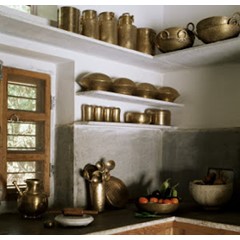
Today, copper, brass, silver and bronze utensils, plates and tumblers are gone in kitchens in middle class and above-middle-class homes all across India in the name of modernity. They were first replaced by stainless steel and aluminum. In recent decades, thermosetting plastics, glassware, and porcelain have entered the cookware market in big ways.
Among the working poor, however, copper and bronze are still used for storing water, cooking and eating. One hopes this stays this way. But plastics and aluminum are making inroads.
This is a great tragedy because copper and copper alloys have antibacterial, antifungal and antiviral — generically known as antimicrobial — properties even at room temperatures. This is something I came to know accidentally in my internet forays. This property of copper and copper alloys can be used cost-effectively for preventing to the extent possible water-borne diseases among the working poor. Poor water quality and sanitation facilities are the bane for the working poor in India. To mitigate this issue, all we need to do is to selectively reinvent copper and brass alloys in kitchenware through proper public health programs.
Here are fascinating reports that the simple copper and copper-rich alloys and the expensive silver have effective antimicrobial properties:
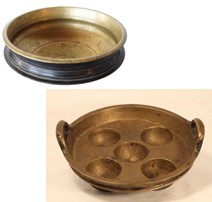
In controlled experiments in labs, when gram-positive and gram-negative bacteria came into contact with metallic copper as foils and plates in water at room temperatures, within in two hours, the water was purified of the disease-causing pathogens, with over 99% of the disease-causing pathogens getting killed. Here is the reference to the first technical paper: Antimicrobial Properties of Selected Copper Alloys on Staphylococcus aureus and Escherichia coli … … by a group of Polish healthcare professionals and metallurgists Anna Rozanska and coworkers. Reference: www.ncbi.nlm.nih.gov/pubmed/28726753.
Here is the authors’ conclusion in their study: “This study confirmed the antimicrobial properties of copper alloys, and additionally showed that Staphylococcus aureus (SA) was more resistant than Escherichia coli in the variant of the experiment without organic contamination. However, even for SA, a total reduction of the bacterial inoculum’s density took no longer than 2 h.†But stainless steel, the ubiquitous metal used today in India for cooking and eating did not have this beneficial property.
Modern medicine has been using silver ions in skin care and for healing wounds. In the prestigious journal Nature (June 19, 2013) is this article by Brian Owens on silver’s efficacy for fighting bacteria: Silver makes antibiotics thousands of times more effective: Ancient antimicrobial treatment could help to solve modern bacterial resistance. The title tells it all. Here is the reference for the article in Nature: www.nature.com/news/silver-makes-antibiotics-thousands-of-times-more-effective-1.13232.
A ton of information is available on the web on the antimicrobial properties on copper and silver. You can start in Wikipedia.
Water-borne diseases are a big problem in Africa and Asia and the Americas as well. People are advised to boil the water — at great expense given the high cost of fossil fuels, or fossil-fuel-generated electricity. So, maybe we need to reintroduce — and rediscover — copper and brass as complementing metals of choice Indian kitchens for storing and serving water in homes. This will help in cost-effectively managing water-borne diseases among the Indian poor, a chronic public health problem having great social and economic costs. End$$$$
The Annual Writers’ Dinner
Posted by admin in January 2020, Past issues on February 20, 2020
By Premlata Venkataraman
This was a valid point. The magazine is meant to be a platform for disseminating information about ourselves to readers scattered around Pittsburgh. We have been doing this for 24 years. Also, this magazine is mailed to many media outlets in Pittsburgh, local libraries, and offices of elected officials. So, we are eager to highlight events in our community.The Patrika can address this with help from the organizers of these events.
But here is the challenge: The Indian population here is thinly scattered over a large area around Pittsburgh and its Metro neighborhood. It is difficult for any one or two people to go to these events to cover these programs. Remember, these people have their own family obligations and social life in addition to holding full-time jobs.
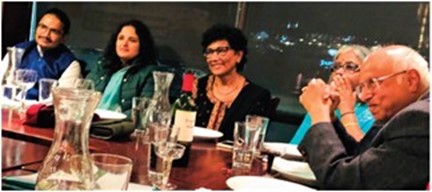
One point many raised was the lack of coverage of the social and cultural programs our readers organize in the eight-county tri-state region of south-western Pennsylvania, Eastern Ohio and the West Virginia Panhandle. The magazine should highlight these events to reach the wider audience of the Patrika.
One possible solution, however: if the organizers of these programs alert us in advance about the events, the Patrika can publicize these events. As a matter of fact, in every issue, we place a boxed item as shown below with red letter caption to draw readers’ attention to this very point. This point was acknowledged by a few among the participants.
We welcome more stories on any topic that interests or provokes them and make this annual event lively. END ï®
Home:
Indian Dances in the Pittsburgh’s Annual Thanksgiving/Holiday Parade
Posted by admin in January 2020, Past issues on February 20, 2020
By Nandini Mandal
Artistic Director, Nandanik School of Dances
On November 30 at 9 AM history was made for the Indian community in Pittsburgh. For the first time, the organizers of the annual WPXI Holiday Parade invited us for the annual outside gala. Having seen our performance at Market Square on 13th and 27th September as part of Welcome Pittsburgh, they invited us to participate in the Thanksgiving weekend in 2019.
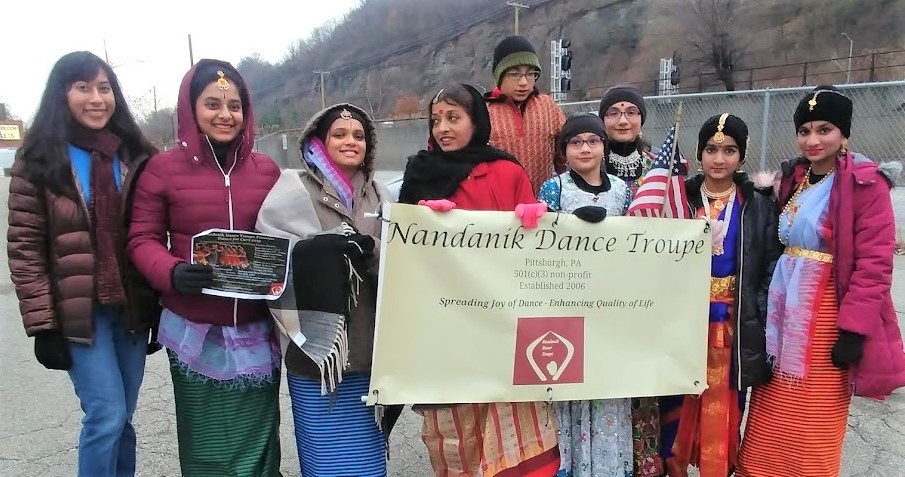
Excited as we all were, we were also worried about the weather. Our Indian dance costumes are meant for the tropical and subtropical weather, so it was a challenge to design our costumes for the outside event in the cold weather. We decided to gear up in outdoor sport wear underneath our Bharatanatyam, Koli, Garba, and Manipuri costumes!
Sixteen dancers participated along with their enthusiastic parents. We gathered at 7:00 am in Strip District braving the subfreezing temperatures. The wind chill was 20 degrees and the mercury was at 30 F, but nothing could dampen our spirits. There were drummers, marching bands, fire brigade, canine troops, and other organizations of this wonderful city and Allegheny County.
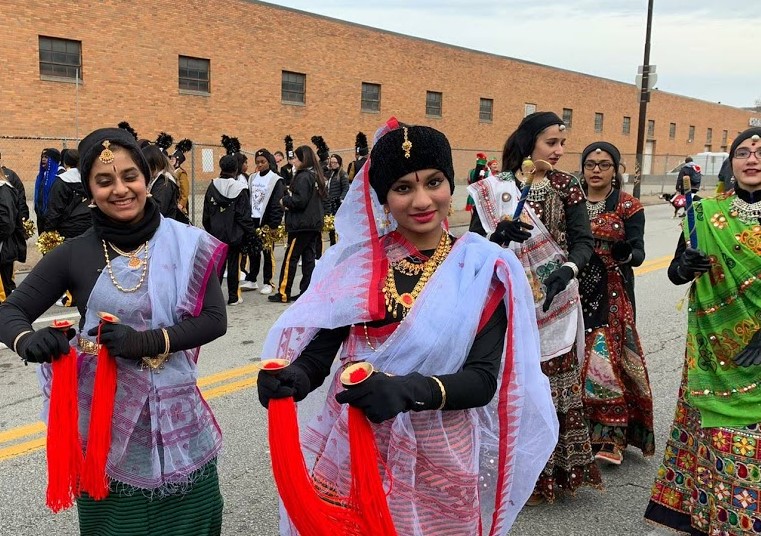
It was a two-mile walk. A crowd had gathered, braving the cold and cheering us along the way. Little children from among the bystanders danced along with us. The fun part was to see ourselves on the big screen and the reporters talking about us on live TV!
For the first time, India was part of the annual gala. We were delighted that the minority Indian-American community was appreciated by all. We contributed in our own way to become part of the American mainstream.
Anushka Sharma, a seventh grader from Upper Saint Clair, said this on her participation: “It was an amazing to perform and share different Indian classical dances with people from my home city. I was happy to get this experience, because we don’t always have a chance to share our Indian culture with people from other cultures.â€
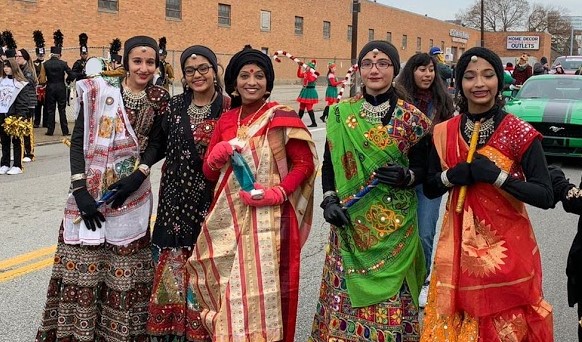
Aditi Thakur, a tenth grader also from the same area said, “The experience overall was fun, albeit a bit cold. It was amazing that we were performing there in the first place. So many people cheered us on, and I felt welcome while performing something from my heritage. In true thanksgiving spirit, I felt connected to the Pittsburgh community and I’m grateful that I got to share my culture with my community.â€
Please mark your calendars for our spring production. VILAYA — The Confluence Festival of Indian classical dances on April 18 and 19 at Andrew Carnegie Free Library & Music Hall at Carnegie. This will be the third year of the festivities as we continue in our mission to promote the rich heritage of Indian art in the greater Pittsburgh region. END ï®

